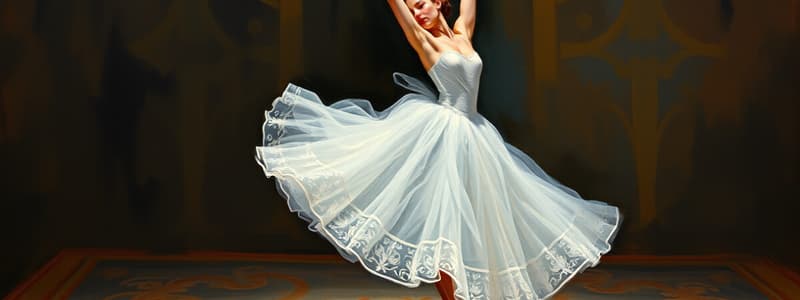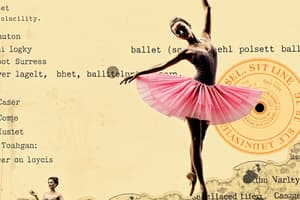Podcast
Questions and Answers
What does 'En L'air' mean?
What does 'En L'air' mean?
- A stationary handrail
- To fall
- To chase
- In the air (correct)
What is an Arabesque?
What is an Arabesque?
A position where the body is supported on one leg, with the other leg extended directly behind the body with a straight knee.
What is a Barre used for?
What is a Barre used for?
- A jump
- To spin
- Support in ballet (correct)
- A leg position
What does 'Port de bras' refer to?
What does 'Port de bras' refer to?
What do 'Chaines' signify in ballet?
What do 'Chaines' signify in ballet?
What does 'Chasse' mean?
What does 'Chasse' mean?
What is a 'Coupe' in ballet?
What is a 'Coupe' in ballet?
What is the meaning of 'Degage'?
What is the meaning of 'Degage'?
What does 'Demi' mean in the context of ballet?
What does 'Demi' mean in the context of ballet?
What does 'Grand' signify?
What does 'Grand' signify?
What is a 'Pas Jete'?
What is a 'Pas Jete'?
What does 'Pas de bourree' refer to?
What does 'Pas de bourree' refer to?
What does 'Passe' mean?
What does 'Passe' mean?
What is a 'Pirouette'?
What is a 'Pirouette'?
What does 'Plie' mean?
What does 'Plie' mean?
What is 'Pointe tendu'?
What is 'Pointe tendu'?
What does 'Rond de jambe' refer to?
What does 'Rond de jambe' refer to?
What does 'Sous-sus' signify?
What does 'Sous-sus' signify?
What does 'Spotting' refer to?
What does 'Spotting' refer to?
What does 'Tombe' mean?
What does 'Tombe' mean?
Flashcards are hidden until you start studying
Study Notes
Ballet Terminology Study Notes
-
En L'air: Refers to movements performed in the air.
-
Arabesque: Position with the body supported on one leg; the other leg extends straight behind.
-
Barre: A stationary handrail that provides support during ballet warm-ups.
-
Port de bras: Movement and carriage of the arms through various positions.
-
Chaines: Series of linked turns executed in a straight line or circle.
-
Chasse: A movement where one foot chases after the other.
-
Coupe: A preparatory step involving one foot cutting away from the other and taking its place.
-
Degage: Movement where the foot is pointed in an open position with an arched instep without transferring weight.
-
Demi: Indicates "half," often used in relation to plie where knees bend but heels remain on the ground.
-
Grand: Means "big," particularly in reference to a plie where the knees bend with heels lifting off the ground.
-
Pas Jete: Means "thrown step," resembling a jump.
-
Pas de bourree: A sideways movement where one foot crosses either behind or in front of the other.
-
Passe: Indicates a working leg passing the knee of the supporting leg.
-
Pirouette: A spin that involves a complete turn of the body on one foot, either on point or demi-point.
-
Plie: Means "to bend," specifically relating to the bending of the knee(s).
-
Pointe tendu: Refers to the position where only the tips of the toes touch the floor.
-
Rond de jambe: Describes a circular movement of the leg.
-
Sous-sus: Translates to "under-over," referring to a releve in fifth position.
-
Spotting: Technique for keeping the head aligned and focusing the eyes during turns and spins.
-
Tombe: Means "to fall," specifically transitioning into a fondu on the working leg.
Studying That Suits You
Use AI to generate personalized quizzes and flashcards to suit your learning preferences.




